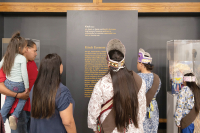WCU moving up on the dial: Winners and losers in the shifting world of radio frequencies
 A protracted tug-of-war over the 95.3 FM radio frequency is finally over, setting the stage for Western Carolina University’s campus-run radio station to expand its reach well beyond Jackson County’s borders.
A protracted tug-of-war over the 95.3 FM radio frequency is finally over, setting the stage for Western Carolina University’s campus-run radio station to expand its reach well beyond Jackson County’s borders.
The frequency 95.3 FM is currently home to WCQS, the primary National Public Radio station serving the mountain region. WCQS broadcasts on nearly a dozen frequencies in its daunting mission to stitch together a footprint across mountainous terrain, a hostile environment for radio signals. In Waynesville, the go-to frequency for WCQS is 95.3, along with parts of Jackson County.
But that frequency has been relicensed to WCU and WCQS will be booted off, impacting thousands of listeners in Waynesville who count on 95.3 FM for National Public Radio — whether it’s the in-depth daily news of All Things Considered or witty weekend shows like Car Talk.
WCQS Program Director Barbara Sayer is quick to point out that WCU isn’t the bad guy kicking WCQS off a spot on the dial it historically occupied.
“They weren’t going after us. This is the just the story of the broadcasting landscape,” Sayer said. “We would have lost that frequency no matter what.”
A reshuffling of radio frequency licenses by the Federal Communications Commission meant WCQS would no longer be eligible to broadcast on 95.3 FM regardless. Once the frequency went up for grabs, WCU merely put its name in the hat.
Related Items
Sayer also assured loyal listeners in Waynesville that they wouldn’t be left high and dry with no NPR, although the specific fix for the conundrum is still in flux. But it’s nothing new: frequency dilemmas are a fact of life for the station.
“We have been tasked with moving frequencies and being vagabonds quite a few times, but if there is a station that is prepared to be agile and innovative, it’s WCQS,” Sayer said. “I have faith we can do that with all of our coverage to the west.”
While losing 95.3 FM is bad news for WCQS, it’s good news for WWCU, the university-run radio station. WWCU currently broadcasts on 90.5 FM, with limited reach outside Jackson County. When it moves to 95.3 FM, the station will reach most of Macon County and a lot more of Haywood.
“The footprint of the radio station over 95.3 will allow the university to serve nearly 70 percent more people in the region than it is currently serving,” said Don Connelly, head of WCU’s Communications Department.
Various entities vied for the 95.3 frequency, but the winner — WCU — is the most favorable for WCQS.
“They will work with us and try to ameliorate how we might be able to maintain our signal in that region,” Sayer said.
Sayer met with Connelly and the WCU Chancellor David Belcher two weeks ago to talk about the options.
For its part, WCU doesn’t want to leave WCQS listeners in Waynesville in the lurch without an NPR station.
“WCQS would lose the large coverage area they currently have on 95.3, and that would be detrimental to public radio and NPR and that type of programming,” Connelly said.
WCU does not plan to carry nationally syndicated NPR programming on its own station, but has offered up its old frequency of 90.5 FM for WCQS to occupy.
Simply switching places may not be a perfect fix, however. The hole left in WCQS’ coverage by losing 95.3 FM could be a bigger hole than 90.5 would fill — 90.5 would fill in missing gaps in Jackson, but not so much in Haywood.
WCQS currently broadcasts over 95.3 FM from a tower on Mount Lynn Lowry, a peak of more than 6,000 feet in Haywood County, with ample line of sight over the greater Waynesville area. The tower for 90.5 FM is at Balsam Gap, on the Haywood-Jackson countyline, which has far more limited reach in Waynesville.
Meanwhile, 95.3 FM will no longer be transmitted from Mount Lynn Lowry, but will be broadcast from a new tower WCU is building in Tuckasegee.
Musical chairs on the radio dial
While listeners in Waynesville have long relied on 95.3 as their go-to NPR station, WCQS has never had a bona fide claim to the frequency. It’s essentially been a squatter on 95.3 FM, using it like a repeater to push signal into an area where its main transmitters don’t reach.
95.3 wasn’t previously in the offings as a formal frequency, because it was already in use by another station in North Georgia.
“There’s only 100 positions on the FM dial. The job of the FCC is to coordinate those frequencies to maintain a separation,” Connelly said.
It’s like the antithesis of a Venn diagram — instead of the circles overlapping, they can’t be touching.
But in 2000, the Georgia station relocated its broadcasting tower further away, creating enough of a separation that 95.3 could become a bona fide station of its own in Jackson County without risk of signal interference. WCQS realized then that its days of camping out on the 95.3 frequency were numbered.
WCQS can be picked up on nearly a dozen frequencies around the mountains, depending on where you are. Four of those — in Franklin, Murphy, Asheville and Mars Hill — are licensed to WCQS as permanent broadcasting signals.
“They are not subject to encroachment,” Sayer said.
But the rest of its signals use frequencies classified as lower-level translators.
“They are not protected even though they are assigned to us,” Sayer explained. “In the domino world of broadcasting where frequencies are reassigned, those could all be endangered. We have been in limbo for many, many years on many, many frequencies so it is not a surprise to us. You have to remain agile, and so far we have managed to do that.”
Just last month, WCQS had to switch the frequency it broadcasts on in Highlands after being bumped by a station in South Carolina. It’s had to play musical frequencies twice in Brevard over the years for the same reason.
“They weren’t gunning for WCQS,” Sayer said. “Sometimes you have no idea what the domino effect will be for frequencies down the line.”
Striking distance
Unfortunately for WCQS, it wasn’t eligible to apply for the 95.3 frequency when it came up for grabs in 2010 as a bona fide licensed station.
FCC rules dictate that the station operating on a frequency must be headquartered locally, which in this case had to be Jackson County.
“We would have not gotten that frequency if we had applied for it,” Sayer said.
So they didn’t bother applying.
WCU was a natural contender, however. New radio frequencies don’t come along often. It’s incredibly rare, in fact, making 95.3 a once-in-a-lifetime chance.
“We had watched the frequency for a number of years,” Connelly said.
For 10 years, in fact, Connelly had been watching and waiting. While the frequency was freed up in 2000, the FCC finally opened it up for station applications in 2010.
It was do-or-die for WCU. If it didn’t land 95.3, it may never have another chance to expand its reach with WWCU.
But WCU wasn’t the only candidate in the running.
Five groups applied for the station. Three of them — religious stations — were deemed ineligible because they weren’t locally based.
“Being local is heavily weighted,” Connelly said of the FCC criteria.
But the fifth candidate, like WCU, claimed the local card: an environmental advocacy group called the Canary Coalition.
Its leader Avram Friedman, a well-known environmental activist in Jackson County, envisioned a grassroots radio station that would give a voice to in-depth coverage of environmental and social justice issues often blacked out by mainstream corporate media. The station would be a forum for thoughts and ideas, provide community education, feature the unsung work of local nonprofits and showcase local musicians.
The Canary Coalition was initially awarded the frequency, but not on the grounds of its proposed programming.
“The FCC is prohibited from judging a station’s programming,” Connelly said.
Instead, the scales tipped in Canary Coalition’s favor because WCU already owned 90.5 FM. The FCC favors diversity on the airwaves, and all else being equal, it favored a new station over one that already had a place on the dial. Friedman said the area could use a grassroots station.
“We were a much better fit. WCU is not a community-based organization,” Friedman said. “I doubt they will serve the community in the capacity that we were.”
WCU appealed the decision, a process that ultimately took four years for the FCC to settle.
This summer, the FCC reversed its initial position and re-awarded the frequency to WCU.
WCU argued in part that the Canary Coalition didn’t have the financial means or technical capability to launch a radio station, and that any claims to the contrary by the Canary Coalition “lacked credibility.”
That argument was never taken up by the FCC, however. Instead, WCU bested the Canary Coalition on a technicality. WCU successfully claimed that the Canary Coalition lacked a physical headquarters, at least according to its application, and thus should be stripped of its local designation, a critical FCC criteria.
The Canary Coalition had listed a P.O. Box as its address in its FCC application, and a P.O. Box does not provide for “sufficient contact between the station’s decision and policy makers and the area to be served.”
The Canary Coalition countered that it indeed had a physical location, even though it wasn’t in the application. But the FCC ruled the Canary Coalition couldn’t retroactively amend the address it initially listed.
“We do not look beyond the four corners of the application. Canary’s application provided nothing more than a post office box for its physical address,” the FCC ruled.
Friedman said it was a shame.
“WCU overpowered the system. They wanted it and they got it because they were able to outspend us,” Friedman said.
But Friedman took the idea born out of his vision for a community radio station and is instead launching Mountain Stream TV, a collaboration with several nonprofits in the mountains.
“That’s more exciting actually,” Friedman said, adding that the radio dial is becoming moot. “Online TV and video is the medium most people are going to be watching anyway.”
What now?
WCU has three years to get up and running on the new frequency of 95.3 or it loses the license. WCU plans to build a new tower to transmit the station from, so it won’t happen any time soon, buying WCQS a little breathing room in the meantime.
Connelly said WCU wants to work with WCQS; WCU doesn’t want to kick it off 95.3 until it’s found somewhere to land.
While the option remains on the table to utilize WCU’s no-longer-needed frequency of 90.5, WCQS is no doubt trolling for other frequencies that would replace its lost signal in Waynesville.
“As the radio dial becomes crowded — and it is already very crowded — the chance of finding another one is a little more difficult and the frequency you find may not perform as well in that location as the previous one did,” Connelly said.
Sayer assuaged any fear listeners may have, however.
“We will work very hard to cover as much of WNC as we can,” Sayer said.
Moving mountains
The mountains are a challenging environment for radio — the ridges and rims, crests and coves, knolls and knobs all stymy the typical range of a signal.
“FM radio is line of sight. If you put a mountain in front of it, it stops the signal,” said Don Connelly, head of Western Carolina University Communications Department.
Scoring a new radio frequency for the campus-run station WWCU was only half the battle. The other half was figuring out where to transmit that frequency from to maximize its reach.
Pulling up a map of the region, Connelly traced the perimeter of the new signal’s range from Franklin to Waynesville, rife with crooked zigzags.
“Those are called mountains,” Connelly said.
In the flat lands, the signal’s reach would be a perfect circle, spreading out like ripples on a pond.
“If we were in Kansas we would put up a tower and the signal would go — it would just go,” Connelly said.
But here, the signal’s footprint looks more like a jigsaw puzzle piece every time a mountain gets in the way. And even within that outline, there’s places the signal won’t penetrate.
“We will forever have people who say my neighbor in the next valley gets you and I don’t. A signal is not like a heat seeking missile seeking a receiver,” explained WCQS Station Manager Barbara Sayer, who battles the same issue as Connelly.
WCU plans to build a new transmission tower on a 360-acre tract owned by the university on Brown Mountain, about 5 miles south of Cullowhee in Tuckasegee. The tract was gifted to WCU in the 1950s and isn’t used for much other than the field excursions of natural resource students.
Brown Mountain sits at 4,000 feet, and the tower would be 118 feet tall. It’s unclear whether the tower would jive with Jackson County’s tower ordinance.
Historically, WWCU transmitted from a tower on the university campus in Cullowhee.
But in a quest to expand its reach 10 years ago, WCU moved its tower to Balsam Gap near the Jackson-Haywood county line. The frequency bleeds into parts of Haywood but becomes spotty by the time it reaches the center of Waynesville before dropping off completely.
That’s by design. The frequency 90.5 FM is used by another radio station in Mars Hill, and another in Chattanooga.
They can’t overlap or encroach on each other, so its reach is intentionally reined in.
To the average radio listener in the mountains, the dial seems anything but crowded, with plenty of wide open air waves playing nothing but static.
But on paper, the dial looks far more congested than it sounds. The Federal Communications Commission calculates a safe distance between stations based on rules that don’t always apply in the mountains.
On paper, a station in Waynesville can’t share the same frequency as a station in Knoxville. But in reality, the massive 6,000-foot mountain ranges between here and Tennessee block any chance that a signal from Knoxville could ever interfere with a station in Waynesville.
Still, frequencies that seem open for the taking are actually off-limits as far as the FCC is concerned, and that complicates things for WCQS as it prowls for a signal to replace the impending loss of its 95.3 FM frequency in Waynesville.
WCQS already faces challenges public radio stations in other places don’t have. The impenetrable mountains require more infrastructure to accomplish coverage, with multiple transmitters and translators leapfrogging over the ridges. Also, there’s fewer listeners per square mile compared to more populated area.
“We have a great deal of coverage area where our listeners are squirrels,” Sayer said.
Fewer listeners means fewer donors, which are the primary funding source for the station.
Still, serving the far western counties despite the pesky mountains is WCQS’ mission.
“More than three decades ago WCQS made a decision to spend in an area we knew would be technically difficult because of the mountains, and that we would never be serving as large a population as if we had gone east,” Sayer said. “But we are completely committed to providing all the service we can in Haywood, Jackson, Macon, Swain — all those counties are very important to us even though it does require more effort and more ingenuity.”
WWCU will up its game with new frequency, bigger reach
What started as small-time campus radio station is about to hit the big leagues.
WWCU is poised to dramatically increase its footprint beyond the current confines of Jackson County within the next two to three years, once it assumes its newly awarded frequency of 95.3 FM.
“We will be looking at who our new listener is. Now we are covering a new geographic area and we need to find out who lives in that area: who is the Mr. and Mrs. 95.3?” said Don Connelly, the head of Western Carolina University’s Communications Department, which runs the radio station now known as Power 90.5.
WWCU’s daytime lineup is anchored by the classic rock genre. But come evening, all bets are off.
“During the day it’s targeting mom and dad and two kids in the car. But at 6 p.m. we roll into a very eclectic mix of programming,” Connelly said.
The station is like a sampler platter, with jazz one night and a sports talk show the next.
“We do a balancing act so everybody gets a piece of the pie so to speak,” Connelly said.
Volunteer DJs have a long leash to try programs revolving around their own interests and music tastes, and that makes for a diverse mix.
Listeners learn when to tune in for their favorites, with longstanding followings for some programs, like C.B. Roy’s Mostly Blues.
“His blues show on Sunday nights is off the charts,” Connelly said.
There’s even an all-Spanish Latino show called Al Aire Libre, the only one in its genre in the region.
“How many Hispanic radio stations do we have in our area? Zero,” Connelly said.
WWCU gets weather forecasts from the Cullowhee-based Local Yokel Weather and broadcasts live coverage of WCU football and basketball games from the Catamount Sports Network.
It also has a two-hour student talk show twice a week and periodically features interviews on public affairs topics, often with WCU faculty and staff. Last Friday, the station was readying for an interview with WCU’s energy czar, Lauren Bishop, who has led university initiatives and campaigns to reduce energy consumption over the past decade.
But the station has more potential than it is realizing, and expectations will no doubt rise as WWCU leaves the safety of its campus cocoon. Once it moves its spot on the dial from 90.5 to its new broadcasting frequency of 95.3, it will cover an area with more than 80,000 potential listeners.
But Connelly said WWCU won’t forget its mission to students and the university.
“The two are compatible,” Connelly said.
Connelly takes pride in the educational role the station serves.
“The station is a professional learning laboratory for students and provides an experiential learning experience,” he said.
A group of philosophy students even tried their hand at a radio program last year, selecting songs to symbolize different philosophical theories.
“These were philosophy students engaged in creating a every unique program,” Connelly said.
The university, after all, is the primary funder for the station. Its annual budget from the university last year was about $60,000.
Connelly gets excited about the many ways students could be engaged in conducting demographic market research of its new base, and modeling how to craft programming that appeals to as many listeners as possible.
It won’t be easy in the on-demand age of media. When people can instantly call up any song or program they fancy with the swipe of a finger, why take the gamble on a radio station that might play a song you love, but might also play one you hate?
There’s one thing about radio that supersedes all that, however.
“Radio is a very intimate experience,” Connelly said.









